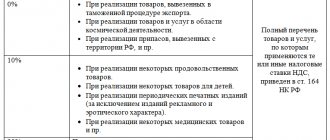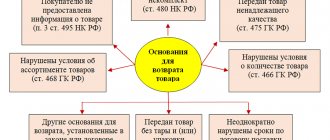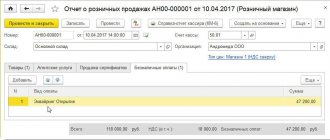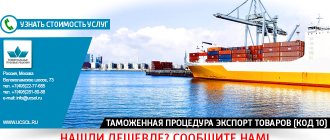Exporting goods and own products outside of Russia is a financially profitable operation for taxpayers. The legislation provides for a special procedure for calculating and refunding value added tax (VAT) for enterprises involved in export activities:
- the VAT rate on goods/services shipped for export is set at 0%;
- tax paid on the purchase of products intended for export abroad is subject to reimbursement from the state budget.
Due to the need to return from the budget VAT paid on Russian territory, fiscal authorities pay special attention to enterprises that use export operations. An unreasonably claimed VAT refund or failure to comply with the regulations for confirming the right to apply a preferential tax rate is fraught with substantial additional payments to the budget and penalties.
Specifics of export VAT
When purchasing goods or producing your own products/work, the cost of a unit of goods initially includes VAT paid to the supplier. When reselling such a product on Russian territory, the company will be forced to pay 10% or 18% of the sales amount to the budget.
If this product is sold to a foreign enterprise, then the exporter’s obligation to pay VAT disappears, since for such transactions a VAT rate of 0% is provided.
Example
Company A. purchased goods for sale in the amount of 118,000 rubles, paying the supplier VAT in the amount of 18,000 rubles. For sales, the company has two options - sell the goods to a Russian company, or transport them to a counterparty in Belarus. The profitability of both transactions should be determined. When selling in Russia:
The sales amount will be 150,000 rubles, of which VAT is 22,881 rubles.
Taking into account the “input” tax, company A. is obliged to pay VAT to the state in the amount of (22881 – 18000) = 4881 rubles. The profit from the operation will be 32,000 rubles, including VAT payable of 4,881 rubles. Net profit – 27119 rubles. When exporting to Belarus:
Sales will be the same 150,000 rubles, however, applying a 0% rate, the company does not charge VAT for payment. In addition, A. has the right to return from the budget the amount previously paid to the supplier in the amount of 18,000 rubles. The profit will be 32,000 rubles, plus the refunded VAT, for a total net profit of 50,000 rubles.
As can be seen from the example, export operations can almost double profits, which is undoubtedly beneficial for a Russian company. However, obtaining increased income is associated with the need to confirm to tax authorities the application of a zero VAT rate.
Accounting for export of goods
All exporting organizations are required to keep records of foreign exchange transactions in accordance with the rules of PBU 3/2006 “Accounting for assets and liabilities, the value of which is expressed in foreign currency,” regardless of the taxation regime. Individual entrepreneurs are exempt from such obligations.
Accounting for transactions on a foreign currency account
Exporters need a foreign currency account to make payments to counterparties in foreign currency. It can be opened in authorized banks in the Russian Federation and abroad.
Transactions on a foreign currency account are reflected in account 52 “Currency accounts”. This is an active account. The receipt of currency is reflected in the debit of account 52, and the write-off is reflected in the credit. Sub-accounts are usually created for it:
- 52.1 - for foreign currency accounts opened in Russian banks;
- 52.2 - for foreign accounts.
The information that is collected in subaccount 52.1 is detailed in two more analytical accounts:
- transit - an intrabank account, which opens automatically along with the current one, is needed to control foreign currency receipts;
- current - money is credited to it after the transit account.
How to record revenue from export sales
Export revenue in accounting is income from ordinary activities. It is reflected in the debit of account 52 by the date of transfer of ownership of the goods to the buyer.
The moment at which ownership will pass to the buyer is usually clearly stated in the contract. But you can simply indicate in the conditions which country’s legislation should be used to determine it.
If ownership passes on the date of shipment and the contract stipulates that the buyer pays for the goods upon receipt, export sales are reflected in the following entries.
- Dt 62 “Settlements with buyers and customers” Kt 90.1 “Revenue” - revenue from the sale of goods is recognized (as of the date of transfer of ownership).
- Dt 52 “Currency accounts” Kt 62 “Settlements with buyers and customers” - payment was received from the buyer of the goods (on the date of payment).
Prepayment is not recognized as income in accounting. If, according to the terms of the contract, the buyer must pay it, the received payment must be reflected as accounts payable.
Upon receipt of prepayment, the postings will be as follows.
- Dt 52 “Currency accounts” Kt 62 “Calculations for advances received” - an advance payment has been received (on the date of receipt of payment).
- Dt 62 “Settlements with customers” Kt 90.1 “Revenue” - revenue from the sale of goods is reflected (as of the date of transfer of ownership).
- Dt 62 “Settlements on advances received” Kt 62 “Settlements with customers” - the previously received advance payment is offset.
When ownership passes after full payment for the goods, two entries must be made as the date of receipt of payment.
- Dt 52 “Currency accounts” Kt 62 “Settlements with buyers” - funds from the buyer have been transferred to the foreign currency account.
- Dt 62 “Settlements with customers” Kt 90.1 “Revenue” - revenue from the sale of goods is reflected.
If an advance payment is provided, the postings will be as follows.
- Dt 52 “Currency accounts” Kt 62 “Calculations for advances received” - an advance payment was received in foreign currency (as of the date of receipt of funds).
- Dt 52 “Currency accounts” Kt 62 “Settlements with the buyer” - full payment has been received from the buyer (as of the date of transfer of ownership).
- Dt 62 “Settlements with the buyer” Kt 90.1 “Revenue” - revenue from the sale of goods is reflected.
- Dt 62 “Settlements on advances received” Kt 62 “Settlements with the buyer” - offset of previously received prepayment.
How to take into account exchange rate differences
In accounting, the amounts of business transactions must be reflected in Russian rubles. Therefore, the foreign currency received from the buyer must be converted into rubles according to the rules of PBU 3/2006. Recalculation is done at the official rate of the Central Bank of the Russian Federation, which is valid for any of the following dates.
- The date of the transaction in foreign currency.
- When preparing financial statements (on the last day of each month, quarter or year).
Received advances and prepayments are converted into rubles only on the date of their receipt and are not subsequently recalculated.
Due to changes in the official exchange rate of foreign currency to the ruble, exchange rate differences of two types may appear.
- Positive exchange rate difference - if the exchange rate has increased since the day of the previous transfer to rubles. It is taken into account in other income and reflected by posting Dt 62 “Settlements with the buyer” Kt 91.1 “Other income”.
- Negative exchange rate difference - if the exchange rate, on the contrary, has decreased. Included in other expenses and reflected by posting Dt 91.2 “Other expenses” Kt 62 “Settlements with the buyer”.
The calculation of exchange rate differences can be formalized using an accounting certificate or developing your own primary form and fixing it in the accounting policy. The buyer does not need to prepare documents for exchange rate differences.
Under the terms of the agreement, the exchange rate may be fixed. Then calculations must be made at this rate, and not at the rate of the Central Bank of the Russian Federation. In this case there will be no exchange rate differences.
Write-off of the cost of purchasing goods
At the same time that revenue is reflected in accounting, the cost of purchasing exported goods must be written off. They do this according to the same rules as when selling goods in Russia.
You can write off using one of the methods established in the accounting policy for accounting purposes:
- at the cost of each unit;
- at average cost;
- at the cost of the first acquisition in time (FIFO).
If the transfer of ownership of the goods took place at the time of shipment, then the write-off is reflected by posting Dt 90.2 “Cost of sales” Kt 41 “Goods”.
If title to the shipped goods passes to the buyer after payment for them or the fulfillment of some other condition (for example, crossing a border):
- Dt 45 “Goods shipped” Kt 41 “Goods” - goods have been shipped to the buyer;
- Dt 90.2 “Cost of sales” Kt 45 “Goods shipped” - the cost of purchasing goods sold is written off.
How to confirm the zero rate for an export transaction
The list of customs documentation attached to the VAT return and justifying the lawful application of the zero tax rate depends on the direction of export operations:
- export of goods to the countries of the Eurasian Economic Union (former republics of the USSR);
- shipment to other countries outside the EAEU.
Export to EAEU countries
When moving goods to the Eurasian Economic Union (EAEU) - Belarus, Armenia, Kazakhstan or Kyrgyzstan - simplified customs regulations are applied, so the list of documents required to justify the application of a 0% rate is quite limited. The seller must present the following documents to the tax service:
- transport and shipping documents for export cargo;
- application documents for the import of goods and confirmation of payment of indirect tax payments by the buyer;
- a contract between a Russian seller and a buyer from the EAEU countries.
Since two-way electronic exchange of data on the import/export of goods has been established between the customs and tax services, the presentation of paper documents is not necessary. It is enough for an exporting company to create a register of necessary documentation in electronic form and submit it to the tax office.
Export to other foreign countries
When exporting goods to countries outside the EAEU, you can confirm the application of a 0% VAT rate with the appropriate documents:
- a copy of the foreign trade contract or, in its absence, an acceptance or offer;
- agreement for the provision of intermediary services - if the export is carried out through a third party (attorney, agent, intermediary);
- customs declaration (copy or register in electronic form);
- commodity and transport documents (bill of lading, CMR waybill, air or combined waybills).
All documents presented must have official marks from customs services, indicating the actual export of goods from the territory of Russia.
During a desk audit, tax authorities may request bank statements or invoices for an export transaction, so it is advisable for the seller to prepare copies of documents to be attached to the VAT return.
Deadline for confirming the legality of applying the zero rate and desk audit
Tax legislation requires the exporting seller to generate and submit a package of necessary documents to the tax service within 180 calendar days after the cargo leaves Russia.
After successful confirmation by the taxpayer of the right to apply the 0% VAT rate, the Federal Tax Service begins a desk audit. It should be borne in mind that the fiscal authority does not control the correctness of a separate export transaction - the entire tax period during which the transaction was completed is subject to verification.
During the desk audit the following is subject to analysis:
- the exporter has the resources necessary for international trade - office, warehouses, staff;
- presence of licensing and permitting documentation;
- timely conclusion of agreements with transport and logistics companies transporting export cargo.
Tax inspectors will most likely conduct counter audits by requesting invoices and invoices from suppliers of goods exported abroad.
If the exporting company has undergone reorganization changes over the past 6 months (change of legal address, merger or incorporation procedures), then the attention of the tax inspectorate to its foreign trade activities will be especially close.
Consequences of non-compliance by the exporter with the prescribed regulations
The absence of a complete package of documents or failure to submit them to the tax authority results in the following sanctions for the exporter:
- additional VAT at a rate of 18% (10% when exporting goods from the relevant list);
- the tax base is determined by the moment the cargo actually crosses the border of the Russian Federation;
- calculation of penalties from the date of shipment of goods.
If the exporter is late in providing documents, he can count on a VAT refund in the next tax period. After the full list of documents is submitted to the Federal Tax Service, the supervisory authority decides to conduct a desk audit. However, this procedure will begin only from the beginning of the next quarter and will last three months.
Participant in foreign economic activity
Each organization that is going to work with foreign partners becomes a participant in foreign economic activity
, therefore the first stage of export is the registration of the company as a foreign economic activity, that is, a participant in foreign economic activity. To do this, you must submit the following documents to customs:
- decision to create;
- memorandum of association;
- charter;
- extract from the Unified State Register of Legal Entities;
- TIN, OGRN;
- certificate from the bank about opening accounts.
This is the main list; you can find out more about what other documents are required in your case from your customs broker.
Voluntariness in applying a zero VAT rate
The use of any benefits for the taxpayer is entirely voluntary. Quite often, organizations do not take advantage of the required concessions if they are not sure that they can reliably and reasonably confirm their right to the benefit.
In contrast to tax privileges established by law, the use of a zero VAT rate for export transactions is a mandatory condition. The taxpayer is not exempt from paying tax; he must, as a general rule, keep records of taxable transactions and submit a VAT return to the tax authority.
In addition, the taxpayer must separate the accounting of transactions at standard rates (10% and 18%) and at the zero rate. “Input” VAT on goods/services subsequently used in export transactions must be accounted for separately. This includes costs for the purchase of materials and raw materials, goods for sale, transport services of third-party companies, rental of warehouses, etc. The entire amount of tax on purchased resources used to ensure exports is subject to reimbursement from the budget, therefore, in order to avoid tax disputes, strict accounting is necessary.
Remember: export transactions are subject to a mandatory invoice with a highlighted zero rate. The document must be issued no later than five days after shipment.
Accounting for customs payments
Reflection of customs duties as part of costs in 1C 8.3 is documented in the document Transaction entered manually, transaction type Transaction in the section Operations – Accounting – Transactions entered manually – Create button.
Let's look at the features of filling out the Operation using an example.
The tabular part of the document is filled in with the following entries:
- Debit – account 44.01 “Costs of distribution in organizations engaged in trading activities”; Subconto 1 – cost item Taxes and fees . Type of expense - Taxes and fees ;
Export customs duties are taken into account as part of distribution costs and are reflected in Dt account 44.01.
Since 2011, account 90.05 “Export duties” has not been used in transactions (Letter of the Ministry of Finance of the Russian Federation dated 01/09/2013 N 07-02-18/01).
- Credit - account 76.09 “Other settlements with various debtors and creditors”; Subconto 1 – customs, selected from the Contractors directory;
- Subconto 2 – agreement on the basis of settlements with customs, Type of agreement Other ;
- Subconto 3 – document of transfer of advance payment to customs;
When can an exporter receive budget money?
Upon completion of a three-month desk audit, the tax service makes a decision in which it orders the exporting company to fully or partially reimburse the “input” VAT paid. The law allocates the supervisory authority no more than 7 calendar days to make a decision.
The taxpayer may declare his intention to use the refund amount to cover the existing arrears on mandatory payments. If such an application is not received by the Federal Tax Service, the compensation amount must be received in the exporter’s current account within five banking days.










